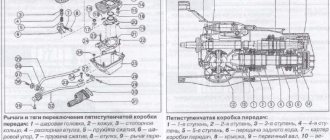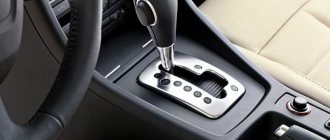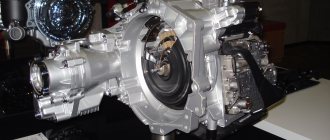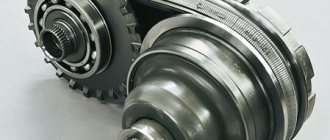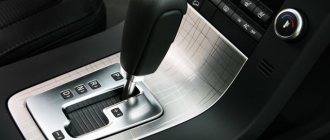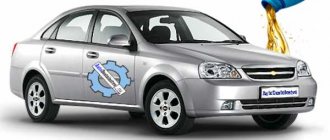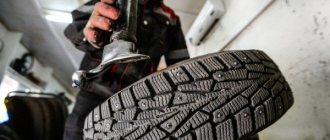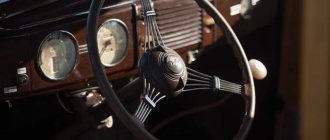In disputes between adherents of various types of transmissions, many copies have been broken. Most drivers with many years of experience who have tried both options have formed their own opinion on this matter, often diametrically opposite. We will try to figure out why opinions on this issue are so contradictory. We assure readers that our goal is not to increase the number of supporters of a particular type of gearbox. We just want to give an objective assessment of the positive and negative aspects of manual and automatic transmissions, providing the opportunity to make the final choice for those who are planning to purchase a new or replace an old car.
What types of checkpoints are there?
The mechanical box is over 130 years old. It is still prevalent today, especially on budget and mid-price class cars. Here, in order to select another gear corresponding to the current speed limit, you need to depress the clutch pedal, which separates the engine and transmission shafts. Everything is quite simple, but when driving in city traffic jams, frequent manipulation of the clutch pedal and gear shift lever takes a lot of effort.
To make life easier for the driver, the designers tried to automate the process. The first automatic transmission appeared in 1928, and mass use began in the post-war years.
Today there are three main types of automatic transmissions:
- classical hydromechanical;
- CVT automatic transmission;
- robotic box.
Let's look at the features of each variety.
The hydromechanical automatic transmission is designed to make life easier for the driver, eliminating the need to squeeze the clutch. Its role is played by a torque converter - a block filled with transmission fluid, which, under the influence of the control unit, forms excess pressure acting on the driven shaft connected directly to the gearbox.
Mechanical box
There is no need to change gears here, but due to the design features, it is not possible to completely get rid of the lever (here it is called a selector), since for such borderline modes as reverse or stopping the car, manual shifting is required. The main disadvantage of automatic transmission is the jerking of the car when changing to higher or lower gears. The efficiency of automatic transmissions is lower than that of manual transmissions due to energy losses in the fluid medium of the torque converter. Hence the increased appetite for cars with automatic transmission.
A type of automatic transmission is a variator, in which the gear ratio is changed by automatically changing the diameter of the drive pulley. Since this happens smoothly, there is no jerking of the car. BUT a torque converter is needed here too - without it the car will not be able to move. This means that the design of the robotic gearbox is becoming more complex and more expensive compared to a conventional automatic machine. As a result, the reliability of the variator is considered less than that of its competitors. There are other disadvantages - for example, the relatively low life of the chain connecting the driving and driven pulleys, the increased role of electronics, which can also be capricious, as well as increased noise during operation.
A robotic gearbox, or simply a “robot,” despite belonging to the automatic transmission class, is a variant of a manual gearbox, but without a clutch pedal - it is replaced by electronics and electric actuators. This is the most economical type of transmission, but even here, due to the presence of the clutch, it cannot do without jerking, especially during active acceleration. So choosing an automatic transmission is not so simple, but we’ll talk about that later.
Characteristics of the mechanical box
Mechanics are the oldest and most proven method of changing gears in a passenger car.
The main distinctive features of the mechanics are:
- rotating torque is transmitted using pairs of gears, which are engaged in the clutch using a speed change lever;
- the box mechanism is designed in such a way that only one adjacent pair of gears is engaged at a certain period of time;
- the clutch is designed to separate the transmission from the power unit;
- the box is durable and reliable;
- Spare parts for this type of box are sold in a wide range and at an affordable price.
To summarize, we can conclude that a manual transmission allows the driver to fully feel (control) the car while driving.
Manual transmission: features, advantages, disadvantages
From a technical point of view, manual transmissions are the most advanced transmissions, but even here progress does not stand still. The design is being improved in different directions, but these changes are not revolutionary in nature.
Manual transmission
Before trying to understand which is better, a manual transmission or an automatic transmission, we list the main advantages of manual transmissions:
- acceleration dynamics are much better than any type of automatic transmission, because you have the opportunity to increase engine speed right up to the red zone. In a car with automatic transmission, switching occurs automatically when a certain crankshaft rotation speed is reached, regardless of the will of the driver;
- Skilled drivers who know how to change gears quickly and also coast the car achieve real fuel savings. With an automatic transmission this is basically impossible to achieve;
- the average capacity of a manual transmission is 3 liters, automatic opponents require 2-3 times more oil;
- If you press the clutch pedal, the engine will be disconnected from the manual transmission. This is important in winter because it makes starting the engine much easier;
- the design of the manual transmission is quite repairable - many car owners manage to repair this unit themselves, but there are no problems at all with service stations;
- slippage on a manual transmission is not as dangerous as on an automatic transmission.
And now about the disadvantages:
- mastering the control of a car with a manual transmission is not an easy task; it is especially difficult for beginners to perform such maneuvers as starting from a stop, especially uphill;
- Beginners also tend to make the mistake of holding the clutch partially depressed unnecessarily, which often causes premature failure of this unit;
- Since the operating modes of the power unit are not electronically controlled, the engine life is shorter due to its increased wear.
Pros and cons of automatic and manual transmissions during operation
Let's take a closer look at the features and nuances of operating a car with an automatic and manual transmission. After which everyone will be able to make a choice for themselves whether a manual or automatic is better for them. To do this, we compare each type of gearbox separately according to various indicators.
Economical
The undoubted advantage of an automatic transmission over a mechanical one is its efficiency. Indeed, due to timely and fast switching, even in city mode, automatic transmission cars consume from 5 to 15% less fuel. In the suburban cycle, this indicator levels out. But this figure is only valid for moderate and non-aggressive driving.
Ease and comfort in movement
The advantages of an automatic transmission according to this criterion are undeniable. After all, the comfort of driving a car with an automatic transmission in a city traffic jam of many kilometers cannot be compared with a manual one. In the case of a manual transmission, you would have to pull the gearshift knob every minute, while an automatic transmission does not require this. The automatic transmission also has excellent overtaking performance. If you have a manual transmission, sometimes you have to switch to a lower gear to accelerate, and then back again. Then the machine independently performs this procedure. In automatic transmissions this function is called “kick-down”.
Another positive argument in favor of automatic transmission is the capabilities of the automatic transmission when starting uphill. If on a manual transmission this procedure requires a certain skill in choosing the engine speed and the force on the clutch pedal, then an automatic transmission is much simpler. I just moved the gearbox lever to move forward, pressed the gas pedal and drove off. But there is one nuance in the operation of automatic transmissions - restrictions on using the car as a tractor. This is due to the design features of the boxes. And if you often tow a heavy trailer with your car, this can significantly reduce the life of the automatic transmission. Also, recently, most automatic transmissions are designed according to the so-called sequential design with two clutches.
Almost all new models of recent years are from brands such as Volkswagen, Audi. Porsche, etc. are equipped with just such robotic boxes. Their superiority over mechanics lies in the fact that these boxes have several preset driving modes and the ability to independently configure a user mode. So, most cars in “sport” gearbox mode have all the advantages of manual gearboxes: fast, and most importantly, timely gear changes when picking up or dropping speed. And most importantly, the vast majority of these gearboxes have the ability to manually change gears using a lever or steering wheel paddles (buttons). This allows the use of an automatic transmission for combined braking. This is probably one of the most serious disadvantages of manual transmissions.
Towing and starting the engine
Only people who are far from cars do not talk about this fact when choosing between an automatic and a manual. And here the opponents, or opponents of automatic transmissions, hit the nail on the head.
How to properly tow a car with automatic transmission
The fact is that to turn on an automatic transmission, unlike a manual transmission, you need a running engine that drives the oil pump. Without its operation, oil will not be supplied to the box under pressure, and accordingly it will not work (transmit force from the wheels to the engine shaft). Same with towing. It is prohibited to tow vehicles with automatic transmission over long distances with the engine turned off. When towing, it is recommended to start the engine and perform the procedure at low speed.
Operation in winter
In this matter, it cannot be said that a manual transmission is much better than an automatic one. But there are still advantages to a manual transmission. And probably the most significant of them is the ability to slow down the engine on ice. With a machine gun, alas, this cannot be done forcibly. You can only release the gas pedal, allowing the gearbox to slow down on its own, shifting gears down. Naturally, in an emergency, such braking is clearly not an option.
A car with an automatic transmission runs the risk of getting stuck in a snowdrift in winter
In addition, one of the most compelling arguments against an automatic transmission is the opinion that the automatic transmission is bad if the car is stuck in a snowdrift. To refute this statement, it is enough to remember that almost all cars with automatic transmission have special electronic traction control systems that will prevent the wheels from slipping. By the way, if the locks don’t work and the car’s wheels are slipping, don’t rush to step on the gas. Since, unlike a manual transmission, an automatic transmission can switch to higher gears, defining slipping as an acceleration section. And this is a direct road to expensive repairs of the gearbox due to its overheating. But you should know that most modern machines have a special operation setting - “winter mode”. Therefore, to some extent, a modern automatic transmission is not much inferior to a mechanical one. But, nevertheless, you will not be able to rock the car in a snowdrift or puddle with an automatic transmission. Therefore, do not tempt fate; it is best, if your car is stuck, to call another vehicle for help and tow the car.
Maintenance
The next disadvantage cited by opponents of automatic transmissions is their expensive maintenance. This is partly correct. Since oil changes, or more correctly called special fluid (automatic transmission fluid) with a filter, are performed much more often in automatic transmissions than in manual transmissions. The reason for this lies in the fact that the automatic transmission does not have a rigid connection to the engine. For these purposes, it is equipped with special torque converters. Where the same ATF is used as a working tool. Naturally, such harsh operating conditions very quickly lead to the liquid losing its properties and, therefore, requiring replacement. The recommended service life between replacing ATF in an automatic transmission is on average about 50 thousand km.
Maintainability
According to statistics in our country, automatic transmission repair services are used 5-6 times more often than manual transmission repair services. However, the statistics of the European Union countries are completely different. There, the number of repairs for automatic and manual transmissions is not much different. This proves the fact that automatic transmissions are quite reliable and can also be used for a long time.
If maintenance is not done on time, the cost of automatic transmission repair can cost a pretty penny...
However, unlike developed countries with an established service and maintenance infrastructure, we have too few specialists in this field. Therefore, there is a certain shortage in providing high-quality, and most importantly correct, services for automatic transmission repair. Components for repairing automatic transmissions cost an order of magnitude higher than those for manual transmissions. Repairing an automatic transmission averages $1,000.
Driving dynamics
Opponents of automatic transmissions say that the acceleration dynamics of an automatic transmission are clearly inferior to a manual transmission. This statement can be argued. Since in recent years, cars of more expensive classes have been equipped with gearboxes that are not only not inferior to mechanical ones in terms of dynamics, but in many ways are ahead of them. Therefore, it is definitely impossible to call this criterion a minus of an automatic transmission.
Price issue
It’s impossible to talk about automatic and manual transmissions without mentioning the cost. Yes, indeed, a car with an automatic transmission costs more than a manual one, with a difference of 1 to 2 thousand US dollars.
Experts' opinion
Many driving instructors, and even road safety experts, have noticed one nuance. As it turns out, a person who has first mastered a manual transmission at an acceptable level can easily transfer to a car with an automatic transmission. But on the contrary, it can be extremely difficult to master a manual transmission after an automatic transmission. Therefore, if this is your first car, it’s better to have a mechanic, and then you can switch to an automatic.
Automatic transmission
There is much more room for improvement here. So, to increase the smoothness of switching, the number of steps (ranges) is increased - today you can often find boxes with 9, 10 or more ranges.
But here, too, everything depends on the type of automatic transmission, and determining which gearbox is better, automatic, CVT or robotic, is not so easy.
Automatic transmission
Let's consider their main advantages:
- in general, the acceleration dynamics of a classic automatic transmission are worse than those of a manual transmission, but modern CVTs and robotic gearboxes are no worse than a manual transmission;
- a classic automatic consumes more fuel, but CVTs, as well as six- to eight-speed gearboxes, also successfully compete with manual transmissions;
- in terms of convenience for the driver, any automatic machine is an order of magnitude better than its mechanical counterpart;
- automation does not allow the driver to overheat the engine, so its service life is generally longer.
There are also disadvantages:
- high oil costs;
- high price;
- complex and expensive repairs.
Automatic or manual
Which is better, a CVT or a manual, we will naturally cover in the article, but first, let’s look at the difference between the so-called classic gearboxes: manual transmission (manual) and automatic transmission (automatic). So, when driving on the highway, the difference between the boxes is noticeable, but not very much. But when driving around the city, the automatic transmission looks much better.
Such boxes will allow the driver not to strain during frequent stops and starts. When passing through traffic jams and traffic lights, an automatic transmission is an ideal option.
Again, when driving on the highway, automatic transmissions have a small advantage, but it will be a godsend for a novice driver. So, in order to quickly change gear from lower to higher speed (for example, to overtake), beginners get lost. But with an automatic transmission you don’t need to switch anything.
On the other hand, although automatic transmission is more convenient, it has noticeable losses in dynamics compared to manual transmission.
In addition, those who choose an automatic or CVT must prepare for frequent filling of the tank with fuel, because cars with such gearboxes consume more gasoline or diesel.
Another difference that sets these two boxes apart is the cost. The price of cars equipped with a CVT or a classic automatic transmission is usually higher than the cost of cars with a manual transmission.
{banner_content}


